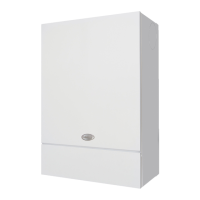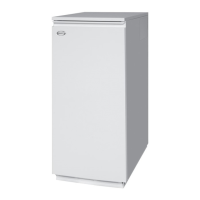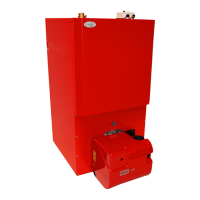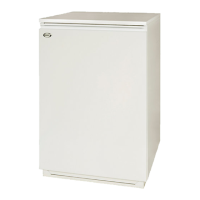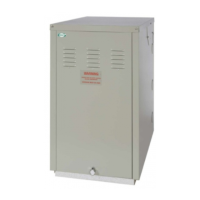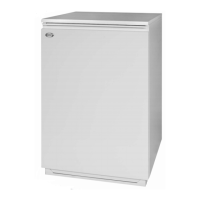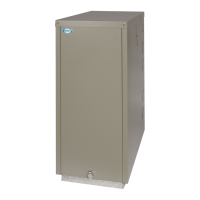10.5 RUNNING THE BOILER
1. Relight the boiler and allow it to run for at least 20 minutes.
2. Check the smoke number, if it is 0-1 then it is satisfactory.
3. Using a calibrated electronic ue gas analyser, set to the
correct fuel, check the %CO
2
in the ue gases.
! NOTE !
To allow the boiler to be commissioned and serviced
correctly a combustion test point is provided on the front
cleaning door. Both the %CO
2
and smoke test may all be
carried out using this test point.
This test point is not suitable for measuring boiler
eciency or conventional ue draught.
4. When using the test point on the cleaning cover note that
the ue gas temperature reading will be higher than that
measured in the ue thus resulting in an inaccurate eciency
reading. To obtain an accurate ue gas temperature and
eciency, the reading can only be measured outside
through the low level ue terminal (or the test point on the
conventional ue starter section when used).
5. For high level and vertical balanced ues, the reading may
be taken from the ue test point provided on the ue system.
6. For conventional ues, a test point is provided in the
conventional ue adaptor for ue draught and ue gas
temperature measurement.
7. Set the %CO
2
, as indicated on the ue gas analyser, to
the required value as given in Section 2.2 for the boiler
concerned.
8. Adjust the burner air damper, using the hexagonal key
supplied, to achieve the required %CO
2
. Refer to Section
11.8.
9. To increase the %CO
2
:
• Turn the screw anti-clockwise. This will close down the
burner air damper and decrease the combustion air
entering the burner.
To decrease the %CO
2
:
• Turn the screw clockwise. This will open up the burner
air damper and increase the combustion air entering the
burner.
10. When the %CO
2
is set to the correct level, re-check the
smoke number if the burner air damper has been moved.
Under no circumstances must the smoke number be above
1.
! NOTE !
For safe and ecient operation of the boiler it is essential
that the air damper is correctly set to give the required
%CO
2
in the ue gases.
10.6 BALANCING THE SYSTEM
1. When the boiler has been adjusted and is running
satisfactorily, balance the central heating system by adjusting
the radiator lock shield valves.
Start with the radiator nearest the boiler and adjust the
valves to achieve the required temperature drop across each
radiator.
If thermostatic radiator valves have been installed, check the
system bypass.
2. Switch o the boiler.
10.7 COMPLETION
1. With the system hot, check again for leaks, rectifying where
necessary. Drain the system while it is hot to complete the
ushing process. Rell and vent the sealed system.
2. A suitable central heating system inhibitor must be added to
protect the system against the eect of corrosion.
3. A suitable antifreeze should be used to prevent damage to
the boiler in areas where electrical power failure can occur in
winter months.
4. Replace the top, front and rear panels as necessary.
! NOTE !
After commissioning the boiler complete the OFTEC CD/11
commissioning report. Leave the top copy with the user
and retain the carbon copy.
If the boiler is to be left in service with the User, set the controls
and room thermostat (if tted) to the User’s requirements.
If the boiler is not to be handed over immediately, close the boiler
fuel supply valve and switch o the electricity supply.
! CAUTION !
If there is any possibility of the boiler being left during
freezing conditions, then the boiler and system should be
drained. Alternatively, a suitable heating system antifreeze
should be used.
10.8 INFORMATION FOR THE USER
The User must be advised (and demonstrated if necessary) of the
following important points:-
• How to start and switch o the boiler and how to operate the
system controls.
• The precautions necessary to prevent damage to the central
heating system and to the building, in the event of the boiler
not being in operation during frost conditions.
• The importance of servicing the boiler to ensure safe and
ecient operation. This should normally be required only
once a year.
• The type of fuel used.
• That any servicing or replacement of parts must only be
carried out by a suitably qualied engineer.
• Ensure that the boiler controls and room thermostat (if tted)
are set to the User’s requirements.
• Tell the User the system pressure and show them the
position of the safety valve discharge pipe.
• Show the User how to reset the overheat thermostat and how
to restart the boiler if it goes to ‘Lockout’.
Page 37Section 10: Commissioning
